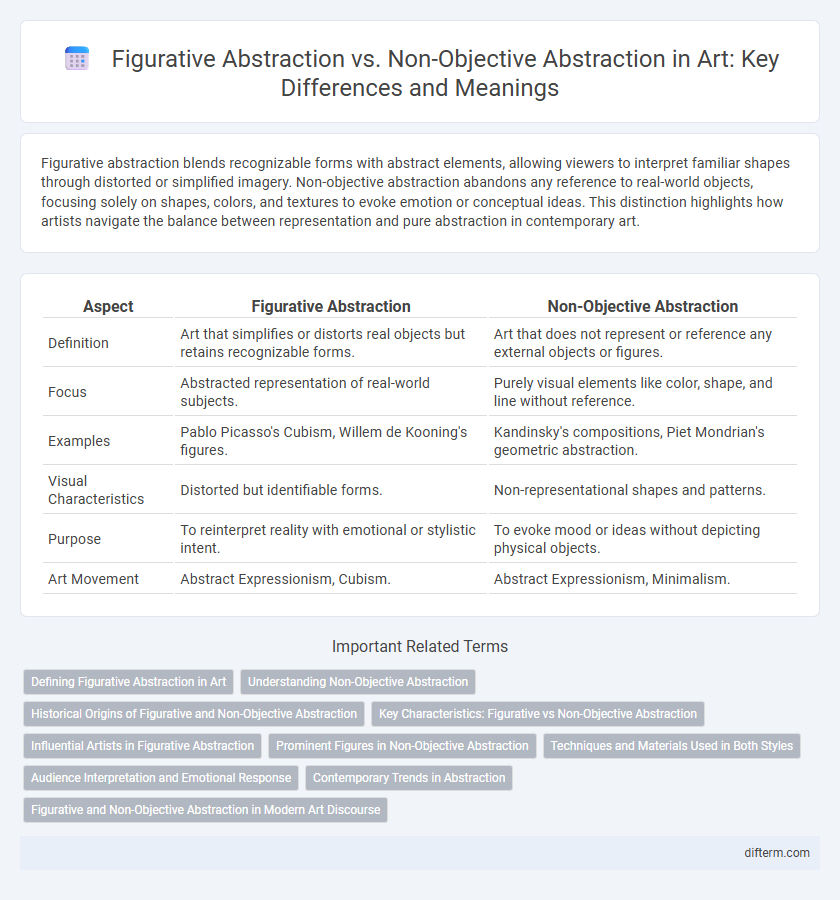Figurative abstraction blends recognizable forms with abstract elements, allowing viewers to interpret familiar shapes through distorted or simplified imagery. Non-objective abstraction abandons any reference to real-world objects, focusing solely on shapes, colors, and textures to evoke emotion or conceptual ideas. This distinction highlights how artists navigate the balance between representation and pure abstraction in contemporary art.
Table of Comparison
| Aspect | Figurative Abstraction | Non-Objective Abstraction |
|---|---|---|
| Definition | Art that simplifies or distorts real objects but retains recognizable forms. | Art that does not represent or reference any external objects or figures. |
| Focus | Abstracted representation of real-world subjects. | Purely visual elements like color, shape, and line without reference. |
| Examples | Pablo Picasso's Cubism, Willem de Kooning's figures. | Kandinsky's compositions, Piet Mondrian's geometric abstraction. |
| Visual Characteristics | Distorted but identifiable forms. | Non-representational shapes and patterns. |
| Purpose | To reinterpret reality with emotional or stylistic intent. | To evoke mood or ideas without depicting physical objects. |
| Art Movement | Abstract Expressionism, Cubism. | Abstract Expressionism, Minimalism. |
Defining Figurative Abstraction in Art
Figurative abstraction in art blends recognizable subjects with abstract elements, distorting or simplifying forms to emphasize expression over realism. This approach preserves a connection to tangible objects or figures while employing abstraction to explore emotional or conceptual depth. It contrasts with non-objective abstraction, which entirely rejects representational references, focusing solely on shapes, colors, and textures without depicting identifiable subjects.
Understanding Non-Objective Abstraction
Non-objective abstraction eliminates recognizable forms to emphasize color, shape, and texture as independent elements, creating compositions that evoke emotion through pure visual language. Unlike figurative abstraction, which distorts or simplifies real-world objects, non-objective art rejects representation entirely, focusing on formal qualities such as line, balance, and spatial relationships. Key artists in this movement include Wassily Kandinsky and Kazimir Malevich, who pioneered visual expressions detached from physical reality to explore pure abstraction.
Historical Origins of Figurative and Non-Objective Abstraction
Figurative abstraction emerged in the early 20th century as artists like Picasso and Braque began to simplify and distort recognizable forms, bridging traditional representation and modern abstraction. Non-objective abstraction, with pioneers such as Kandinsky and Malevich, originated from a desire to create art independent of visual references, focusing on pure form, color, and composition. Both movements influenced the trajectory of modern art but diverged sharply in their treatment of subject matter and the role of observation.
Key Characteristics: Figurative vs Non-Objective Abstraction
Figurative abstraction retains recognizable elements from the natural world, blending realistic forms with abstract techniques to evoke emotion and conceptual ideas while maintaining some degree of representation. Non-objective abstraction eliminates references to real-world objects entirely, focusing on shapes, colors, lines, and textures to create compositions independent of visual reality. Key characteristics distinguish figurative abstraction by its identifiable subjects and narrative potential, whereas non-objective abstraction emphasizes pure visual language and formal innovation without representational anchors.
Influential Artists in Figurative Abstraction
Influential artists in figurative abstraction include Willem de Kooning, whose dynamic brushwork merges recognizable human forms with abstract expressionism, and Francis Bacon, known for distorting the human figure to evoke emotional intensity. Lucian Freud's intense, textured portraits emphasize the physicality of the figure while maintaining abstract qualities. These artists bridge the gap between representation and abstraction, enriching the development of contemporary figurative art.
Prominent Figures in Non-Objective Abstraction
Non-objective abstraction, characterized by the absence of recognizable subjects, was pioneered by prominent figures such as Wassily Kandinsky, who is often credited as a founder of abstract art with his focus on color and form to evoke emotion. Another key artist, Kazimir Malevich, advanced Suprematism by emphasizing pure geometric shapes and a limited color palette, stripping art to its essence. Piet Mondrian's neoplastic compositions, with their precise grids and primary colors, further defined the movement, prioritizing universal harmony over figurative references.
Techniques and Materials Used in Both Styles
Figurative abstraction employs traditional materials such as oil paint and ink, often combined with mixed media to distort recognizable forms while maintaining a connection to reality. Non-objective abstraction utilizes diverse techniques including collage, digital art, and unconventional materials like plexiglass or metal to explore pure forms, colors, and textures without referencing real-world objects. Both styles experiment with layering and texture but differ fundamentally in their emphasis on representation versus complete abstraction.
Audience Interpretation and Emotional Response
Figurative abstraction blends recognizable forms with abstract elements, guiding the audience toward specific emotions tied to familiar imagery, enhancing personal connection and interpretive depth. Non-objective abstraction removes representational references entirely, inviting viewers to engage with pure color, shape, and composition, often eliciting a more subjective and visceral emotional response. Audience interpretation varies widely between the two, with figurative abstraction offering contextual cues while non-objective abstraction emphasizes individual emotional resonance through ambiguity.
Contemporary Trends in Abstraction
Contemporary trends in abstraction reveal a dynamic interplay between figurative abstraction, which retains recognizable subjects distorted through geometric forms and expressive brushwork, and non-objective abstraction, which emphasizes pure color, shape, and composition independent of visual references. Leading artists such as Julie Mehretu and Amy Sillman explore figurative abstraction by merging symbolic imagery with layered textures, while innovators like Ellsworth Kelly and Frank Stella push non-objective abstraction through minimalist and hard-edge painting. This evolving dialogue reflects a broader shift in contemporary art towards hybrid visual languages that challenge traditional distinctions and invite diverse interpretive experiences.
Figurative and Non-Objective Abstraction in Modern Art Discourse
Figurative abstraction integrates recognizable forms from reality, redefining them through abstract techniques to evoke emotional or conceptual responses, prominently featured in movements like Cubism and Abstract Expressionism. Non-objective abstraction eliminates representational references entirely, focusing on colors, shapes, and textures to convey meaning, as seen in works by artists such as Wassily Kandinsky and Piet Mondrian. Both approaches challenge traditional perceptions of form and content, driving ongoing discourse in modern art about the boundaries between representation and pure abstraction.
Figurative abstraction vs Non-objective abstraction Infographic

 difterm.com
difterm.com